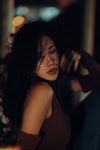The Herlitzka & Co gallery exhibits a sample of textile works that reveal a subtle plot of Latin American culture
The first thing that catches the visitor's eye are two giant balls of wool resting on the floor. The object is an emblem in the work of the Argentine visual artist Teresa Pereda . Accompanying the skeins in the room are photographs of a man with a mixed complexion, submerged in the water of a river in the Amazon, two hundred kilometers north of Manaus, and a video that witnesses the journey of the strands during Pereda's work. , Appointment with the jungle. Ecopoetic actions in the Brazilian Amazon (2008).
Since the 90s, transhumance is the methodology that guides the artist's itineraries and the way in which she defines the locations for her performances. In her work, Teresa exchanges stories and lands ; She puts together balls and lets them unravel and guide her through the earth, which is the support and object of her work: there the ball is put together and taken apart, and with it the wool is interwoven in a continuous act of exchange, of giving and receiving. .
“ The ball, witness of America, does not stop rolling, while its original memory unites different geographies . In its path it crosses native soils and incorporates part of those substrates, leaves, bark, lichens, gravel. It adapts, softly, to roughness and distance to unite, link, move, roll,” says Pereda. Today I remember that the wool smelled strong, white and greasy. A mixture of bleats, urine, grease and fermented grass brings back memories of shearing. The wool, made into fleece, was stowed in burlap bales.”
Teresa's ball gives a clue as to how this exhibition continues with textile-based work and narratives from America. The Bolivian artist Andrés Bedoya presents a black cloak woven with locks of Bolivian women's hair and fabric . The hair carries not only the stories of the women to whom it belonged but also of Bolivian folklore and its traditional carnivals for which women put on braided hair extensions. “The long, braided hair of women in Bolivia is part of the country's culture,” Bedoya clarifies to LA NACION. It is a corporeal work, with the temperature given by both the woman's hair and the repetition of the ritual gesture of weaving.
The anonymous wicks of Bedoya's cloak dialogue with cloaks woven by anonymous weaving artists in the mid-20th century in central and northern Argentina. In turn, the embroidered motifs of flowers, plants and the symbols of the American and Andean repertoire, converse with the tapestries made of burlap bags with chakana symbols , by Candelaria Traverso. “It is a symbol that brings together information; the matrix to understand the Andean worldview , that other way of looking at existence. Chakana means bridge or ladder,” Traverso clarifies in reference to the different times and worlds: the bass, of the ancestors; and the tall one, of the subtle.
But like a book, there are also open plots in this journey. The work of Marcela Astorga reflects this: reddish and grayish fabrics unravel and fall with force, coming out of the bars that cover them. There is something that unravels as if leaving the skin of the body exposed and opening the door to a new history and possible reality.





0 Comments